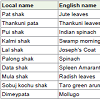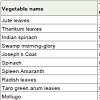Research Article
Phytochemicals - Tannins in some LeafyVegetables of Bangladesh
Rumana Tahati Tuli1, Mohammad Mahfuzur Rahman2 Abu Tareq Abdullah2, M. Akhtauzzaman1 and Sheikh Nazrul Islam1*
1Institute of Nutrition and Food Science, University of Dhaka, Dhaka, Bangladesh
2Food Safety Laboratory, Institute of Food Science and Technology, Bangladesh Council of Scientific and Industrial Research, Dhaka, Bangladesh
Corresponding author: Sheikh Nazrul Islam, Institute of Nutrition and Food Science, University of Dhaka, Dhaka - 1000, Bangladesh, Tel: +880 01817522414; Fax: +880 2 9667222; E-mail: sheikhnazrul@du.ac.bd
Citation: Tuli RT, Rahman MM, Abdullah AT, Akhtauzzaman M, Islam SN. Phytochemicals - Tannins in some Leafy Vegetables of Bangladesh. Indian 02 J Nutri. 2016;3(2): 150.
Copyright © 2017 Tuli RT, et al. This is an open access article distributed under the Creative Commons Attribution License, which permits unrestricted use, distribution, and reproduction in any medium, provided the original work is properly cited.
Indian Journal of Nutrition | ISSN: 2395-2326 | Volume: 3, Issue: 2
Submission: 10/12/2016; Accepted: 09/01/2017; Published: 13/01/2017
Abstract
Ten leafy vegetables commonly consumed by local people of Bangladesh were analyzed to estimate total tannin content in them. Folin-Ciocalteu Phenol reagent was used to determine the tannins content. Results showed that Thankuni leaves (Centella asiatica) contained the highest content of tannins (238.32 ± 28.40 mg/100g fresh edible portion), and it was followed by jute leaves (Corchorus capsularis) (175.37 ± 4.34 mg/100g fresh), Taro green arum leaves (Colocasia esculenta) (97.28 ± 11.04 mg/100g fresh), Lalshak (Joseph’s coat) (96.73 ± 2.65 mg/100g fresh). Lowest amount was found to be in the Radish leaves (Raphanus sativus) (13.57 ± 1.13 mg/100g fresh). This finding to some extent is similar to those reported for some leafy vegetables previously. Plant tannins have a variety of health benefits and intake of tannin containing diet could help in good health maintenance.
Keywords: Tannins; Leafy vegetables
Introduction
The tannins are water soluble polyphenols that are widelydistributed in almost all plant foods [1]. Phenolic compounds are potential phytochemicals, which have important health promoting properties. Tannins are antioxidants containing nutraceuticals and are suggested to be cardioprotective, anti-inflammatory, immunemodulatory, anti-carcinogenic and anti-mutagenic [2]. It enhances glucose uptake, induce beta cell generation and increase insulin activity [3,4]. Itsanti-inflammatory effect helps control gastritis, esophagistis, enteritis, and irritating bowel disorders. It also heals burns and internal wounds, and is effective in protection of kidneys. Tannins have also been reported to use for immediate relief of sore throats and diarrhea [5].
Tannins are classified into hydrolysable tannins and condensed tannins. The first one is usually present in low amounts in plants(gallotannins, ellgitannins) and the condensed tannins are a group ofnaturally occurring polyphenolic bioflavonoids (catechins) [2]. Tea, coffee, supari, apples, dry fruits, mint etc. are rich sources of tannnis. Condensed tannins are widely distributed in fruits, vegetables, and certain food grains and legume. It is reported that protective effect of tannins against so many diseases is because of its capacity to act as free radical scavengers and to activate antioxidant enzymes; it is particularly due to the condensed tannins- catechins. The present article reports total tannins content in some leafy vegetables commonly consumed in Bangladesh.
Methods
Reagents and chemicals
The analytical grade methanol and hydrochloric acid were purchased from Merck (Darmstadt, Germany). Folin-Ciocalteu Phenol reagent and tannic acid were obtained from Sigma Chemical Co. (St. Louis, MO, USA).
Vegetable sampling and identification
Food samples need to represent that-"what the mass people consume" and "from where they collect it"? [6]. Therefore, the leafy vegetables were collected from the retail markets located at fourwholesale markets where the vegetables arrive from four geographicalregions of the country. Then it was ensured the representative vegetables of all geographical locations of Bangladesh.
Ten commonly consumed vegetables [Table 1]; at least two samples of each of approximately 1.0 kg were collected from each location and were taken to the laboratory. The collected vegetableswere identified and certified by a taxonomist of the Department of Botany, Dhaka University.
Processing of vegetable sample
The edible portion of the samples were separated and washed with tap water followed by distilled water. After removing the surface water, the air dried samples were cut into small pieces, weighted (100 g) and freeze dried. The freeze dried samples were homogenized using a grinder. The ground samples were stored in air-tight glass vials in a desiccator.
Sample extraction
Two grams of freeze dried ground sample was taken in a conical flask, to which 42.5 ml methanol and 7.5 ml 1N hydrochloric acid were added. It was allowed to soak in the solvent at room temperature for 24 hours with intermittent shaking. The extract was filtered through no. 1 whatman filter paper. The filtrate was evaporated by a rotary evaporator to concentrate the extracts. After evaporation, methanol was added to concentrate to make volume 10 ml.
Determination of total tannins
Total tannins content was determined by Folin-Ciocalteu Phenol reagent with some modification [7]. Five microliter of the sample extract was added into 2.5 ml of Folin-Ciocalteu reagent and 2 ml of 7.5% sodium carbonate solution. The mixture was shaken well, kept at 40 °C temperature for 30 min and absorbance was measured at 700 nm with the UV/Visible spectrophotometer. Blank was prepared with reagent instead of the sample. Total tannin content was determined from calibration curve made with standard tannic acid (Sigma Chemical Co (St. Louis, MO, USA).
Results
Table 2 shows the tannin content in ten leafy vegetables. Thankuni leaves (Centella asiatica) contained the highest content of tannin (238.32 ± 28.40 mg/100g fresh edible portion) followed by jute leaves (Corchorus capsularis) (175.37 ± 4.34 mg/100g fresh), Taro green arum leaves (Colocasia esculenta) (97.28 ± 11.04 mg/100g fresh), Lalshak (Joseph’s coat) (96.73 ± 2.65 mg/100g fresh). Radish leaves (Raphanus sativus) contained the lowest amount of tannins (13.57 ± 1.13 mg/100g fresh).
Discussion
The finding of the present work, to some extent, is similar to those reported for some leafy vegetables in India [8]. Literatures on tannins composition in vegetables, particularly in leafy vegetables are very few or scanty. However, a number articles reports the health benefit of tannins [2]. The health benefit activity of tannins is mostly due to its catechins metabolite. Anti-nutrient properties of tannins such as decrease of food intake, growth rate, food efficiency, metabolizing energy and protein digestibility have also been reported elsewhere [1,8,9].
Conclusion
Tannins are a unique phytochemical, particularly in terms oftheir vast potential health benefit. Analysis of tannins composition in different plant foods including ethnic plant foods would encourage their consumption for maintenance of good health.
References
- Chung KT, Wong TY, Wei CI, Hung YW, Lin Y (1998) Tannins and humanhealth: a review. Crit Rev Food Sci Nutr 38: 421-464.
- Kumari M, Jain S (2012) Tannins: an antinutrient with positive effect to manage diabetes. Res J Recent Sci 1: 1-8.
- Kim MJ, Ryu GR, Chung JS, Sim SS, Min DS, et al. (2003) Protective effectsof epicatechin against the toxic effects of streptozotocin on rat pancreatic islets: in vivo and in vitro. Pancreas 26: 292-299.
- Anderson RA, Polansky MM (2002) Tea enhances insulin activity. J AgricFood Chem 50: 7182-7186.
- Bruyne TD, Pieters L, Deelstra H, Vlietinck A (1999) Condensed vegetables tannins: biodiversity in structure and biological activities. Biochem Syst Ecol 27: 445-459.
- Greenfield H, Southgate DAT (2003) Sampling: In: Food Composition Data: production, management and use, FAO, Rome, Italy. Chapter 5, pp. 63-82.
- Blainski A, Lopes GC, Palazzo de Mello JC (2013) Application and analysisof the folin ciocalteu method for the determination of the total phenoliccontent from Limonium Brasiliense L. Molecules 18: 6852-6865.
- Gupta S, Lakshmi AJ, Manjunath MN, Prakash J (2005) Analysis of nutrient and antinutrient content of underutilized green leafy vegetables. LWT - Food Sci Tech 38: 339-345.
- Agbaire PO (2012) Levels of anti-nutritional factors in some common leafy vegetables of southern Nigeria. Afr J Food Sci Tech 3: 99-101.


